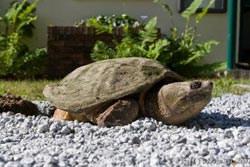Snapping turtles finding refuge in urban areas while habitats are being polluted

While snapping turtles are not aggressive animals, researchers warn not to approach the animals if they are spotted nearby.<br><br>Credit: Bill Peterman/University of Missouri<br>
In the Midwest, people have a fear of encountering snapping turtles while swimming in local ponds, lakes and rivers.
Now in a new study, a University of Missouri researcher has found that snapping turtles are surviving in urban areas as their natural habitats are being polluted or developed for construction projects. One solution is for people to stop using so many chemicals that are eventually dumped into the waterways, the scientist said.
“Snapping turtles are animals that can live in almost any aquatic habitat as long as their basic needs for survival are met,” said Bill Peterman, a post-doctoral researcher in the Division of Biological Sciences at MU. “Unfortunately, suitable aquatic habitats for turtles are being degraded by pollution or completely lost due to development. We found that snapping turtles can persist in urbanized areas, despite the potential for more interaction with humans.”
Peterman said that reducing negative inputs, such as waste and harmful chemicals, into waterways will help restore snapping turtles' habitats. Engaging in this type of environmental action also will increase biodiversity in those habitats and improve the quality of life to all species that call those habitats home.
However, even though turtles are living in urban areas, Peterman says people have nothing to fear.
“Everyone has a snapping turtle story, but some are just too far-fetched and lead to false accusations,” Peterman said. “In reality, snapping turtles aren't aggressive animals and won't bite unless they are provoked. So, if you should happen to see one around your property, simply leave it alone and let it go about its business.”
The study took place in the Central Canal that flows through urban Indianapolis; researchers used tracking devices on large snapping turtles to monitor turtle movements. Peterman and his colleagues found that snapping turtles used all parts of the Central Canal, but were particularly dependent upon forested areas.
“While we didn't study whether the snapping turtle populations were increasing or decreasing, we regularly saw hatchling and juvenile snapping turtles,” Peterman said. “Snapping turtles may not be the first animals that come to mind when thinking about urban wildlife, but if we continue to improve waterways in more places, such as big cities, than the species can coexist peacefully.”
The study, “Movement and Habitat Use of the Snapping Turtle in an Urban Landscape, was published in Urban Ecosystems, and was co-authored by Travis Ryan, associate professor and chair of the Department of Biological Science at Butler University; Jessica Stephens, from the Department of Plant Biology at the University of Georgia-Athens; and Sean Sterrett, from the School of Forestry and Natural Resources at the University of Georgia-Athens. This study is part of ongoing research in urban ecology, conducted through Butler University's Center for Urban Ecology.
Media Contact
More Information:
http://www.missouri.eduAll latest news from the category: Ecology, The Environment and Conservation
This complex theme deals primarily with interactions between organisms and the environmental factors that impact them, but to a greater extent between individual inanimate environmental factors.
innovations-report offers informative reports and articles on topics such as climate protection, landscape conservation, ecological systems, wildlife and nature parks and ecosystem efficiency and balance.
Newest articles

Superradiant atoms could push the boundaries of how precisely time can be measured
Superradiant atoms can help us measure time more precisely than ever. In a new study, researchers from the University of Copenhagen present a new method for measuring the time interval,…

Ion thermoelectric conversion devices for near room temperature
The electrode sheet of the thermoelectric device consists of ionic hydrogel, which is sandwiched between the electrodes to form, and the Prussian blue on the electrode undergoes a redox reaction…

Zap Energy achieves 37-million-degree temperatures in a compact device
New publication reports record electron temperatures for a small-scale, sheared-flow-stabilized Z-pinch fusion device. In the nine decades since humans first produced fusion reactions, only a few fusion technologies have demonstrated…





















